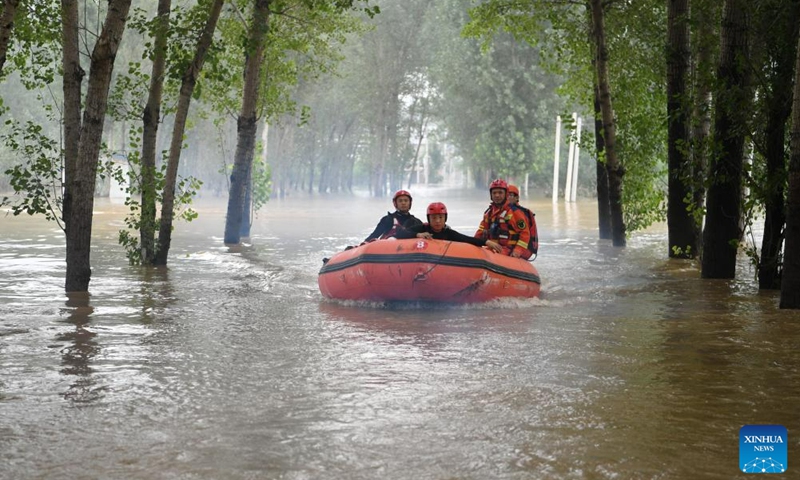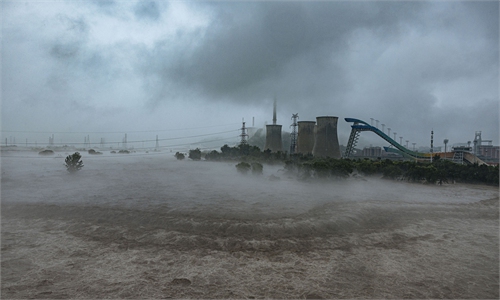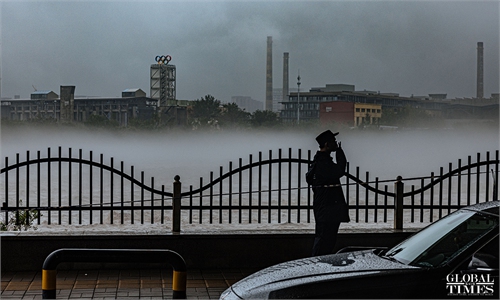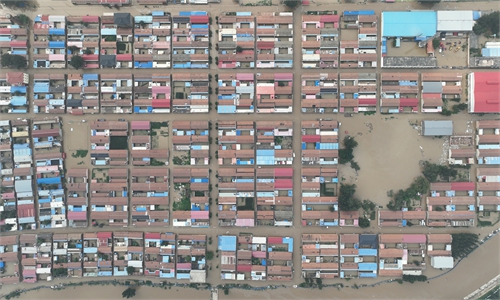China allocates funds to repair flood-damaged infrastructure; NE China ups warning for disasters

Rescuers head towards Shawo Village of Matou Town to carry out rescue operation in Zhuozhou, north China's Hebei Province, Aug. 3, 2023. Zhuozhou City is an area in Hebei that has been severely affected by rain-triggered floods. Local authorities set up 28 emergency rescue teams with a total of 8,755 people to help with the rescue and relief efforts. They worked in collaboration with soldiers stationed there and professional rescue teams.(Photo: Xinhua)
As Typhoon Doksuri continues to batter China, bringing extreme downpours and floods, multiple ministries in China have allocated large amounts of funds to support disaster relief and post-disaster recovery and reconstruction in the Beijing-Tianjin-Hebei region, while Northeast China has upped warnings as it gears up for disaster prevention.
Heilongjiang on Friday issued consecutive meteorological risk warnings for small- and medium-sized river flooding and a red alert for heavy rain.
The Friday warning is the fifteenth red alert for torrential rain issued by the Heilongjiang meteorological bureau since Wednesday, when Typhoon Doksuri moved further north hitting the region.
During the past three days, 31 weather stations in Heilongjiang recorded accumulated precipitation exceeding 250 millimeters, according to the provincial meteorological bureau, with 27 county-level stations breaking the record of daily extreme values.
The highest precipitation in the province appeared in Guoqing village of Wuchang city, reaching 342.8 millimeters. As a precaution, nearly 20,000 affected people in the city were relocated, China News Service reported.
On Friday morning, a 100-meter-long bridge collapsed in Wuchang, with no casualties reported. Traffic control measures have been put in place, and the site is undergoing repair work, media reports said.
The incident followed an expressway bridge collapse in Heilongjiang on Thursday, which led to two cars falling into the water.
Heavy rainfall in Northeast China is expected to continue over the following three days. Mountainous areas are at high risk of secondary disasters such as flash floods, landslides, collapses, and mudslides, with experts calling on relevant departments to take proactive measures.
As the northeast of the country grapples with extreme weather, North China's Hebei Province is sparing no efforts to ensure people's lives get back on track as soon as possible.
China's Ministry of Finance and Ministry of Water Resources on Friday urgently allocated 450 million yuan ($63 million) for water disaster relief in response to damage caused by Typhoon Doksuri in the Beijing-Tianjin-Hebei region. This funding will support the region to seize the critical period in flood prevention, repairing damaged infrastructure such as embankments, reservoirs, pumping stations, and river channels, China Central Television reported.
The National Development and Reform Commission (NDRC) issued on Friday an additional 100 million yuan in funds to support the post-disaster recovery and reconstruction of infrastructure and public service facilities in the severely affected areas of Hebei and Tianjin. So far, the NDRC has allocated a total of 100 million yuan for Hebei, and 50 million yuan each for Beijing and Tianjin.
All 402 villages in Hebei's worst-hit city of Zhuozhou have had contact restored after the last 28 villages with potential risks of communication loss were fully examined, authorities said on Friday, adding that a total of 150 communication base stations have been restored in the city, with 211 stations still out of service, accounting for one fifth of the total.
Waterlogged drains and water supply problems in Zhuozhou are also being addressed to fully ensure the livelihood of affected people.
The Ministry of Housing and Urban-Rural Development has dispatched special working groups to aid Zhuozhou, organizing four sets of large-scale emergency drainage units and 14 vehicles, with a total drainage capacity of 12,000 cubic meters per hour. Priority will be given to draining hospitals, power substations, and heavily flooded large residential areas.
However, Laishui County, another region in the province severely impacted by the floods, is still struggling to save lives. According to local officials, 15 towns and 284 villages in the county have been affected, with a total affected population of 73,000.
Contact is still cut off in a few villages, with villagers trapped in their homes, and communication in some mountainous areas has not been restored. Service providers are urgently dispatching drones, emergency communication vehicles, and other support to the region, media reports said.
Ma Jun, director of the Beijing-based Institute of Public and Environmental Affairs, told the Global Times on Friday that compared to the period from 1975 to 2014, extreme precipitation in China is expected to increase and intensify from 2015 to 2054, particularly in North and Northeast China.
The occurrence of extreme precipitation events is not a "black swan" but rather a "grey rhino," and is becoming more frequent and severe, the expert said, warning that relevant departments should not regard it simply as a "rare incident."



